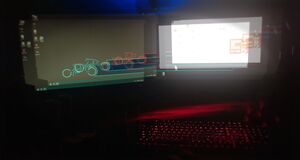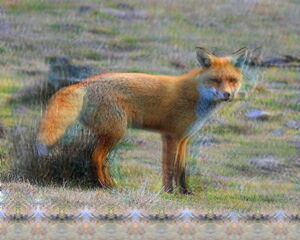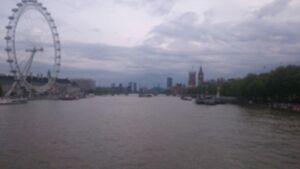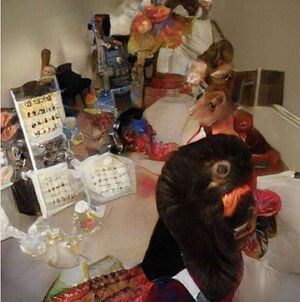Visual suppressions
Visual suppressions are defined as any subjective effect which decreases a person's ability to perceive the external environment through their sense of sight.
This page lists and describes the various visual suppressions which can occur under the influence of certain psychoactive compounds.
Colour suppression
- REDIRECT Color depression
Double vision
Double vision (also known as diplopia) is medically defined as the experience of seeing a single object as a separate image by each eye[1][2], similar to that which occurs when one crosses their eyes. Depending on the intensity, this effect can result in a reduced ability to function and perform basic tasks which necessitate the use of sight.
The effect can easily be suppressed by closing one eye. This suggests that double vision may occur when the brain overlays the data received from both eyes on top of each other incorrectly, without merging the information into a singular 3-dimensional image as it normally would during everyday life.
This effect is capable of manifesting across the 3 different levels of intensity described below:
- Subtle - At the lowest level, double vision is subtle and mostly ignorable in a manner which, although obviously present, is still not intense enough to render the person incapable of perceiving visual details necessary for tasks such as reading text or crossing a busy street.
- Distinct - At this level, double vision becomes intense enough to result in extreme difficulty performing tasks which require the perception of fine details, such as reading. However, the perception of large-scale details such as the person's general environment tends to remain readily perceivable with both eyes open.
- Intense - At the highest level, double vision becomes so intense that the person will no longer be able to accurately perceive small and large-scale visual details of their environment. This will necessitate that the person closes one of their eyes at all time in order to function as they would sober.
Double vision is often accompanied by other coinciding effects such as visual acuity suppression and pattern recognition suppression. This effect is most commonly induced under the influence of moderate dosages of depressant and dissociative compounds, such as alcohol, quetiapine, ketamine, and DXM.[3] However, it can also occur much less consistently under a wide range of other classes of compounds such as hallucinogens, stimulants, anticholingerics, SSRI's, opioids, GABAergics, and cannabinoids.
Image examples
| Caption | |
|---|---|
 | Double vision at a desk by Anonymous |
 | Double vision on a PC by Arnold Layne |
 | Double vision on a fox by Arnold Layne |
 | Desktop double vision by Chelsea Morgan |
 | Double vision in a kitchen by Anonymous |
Pattern recognition suppression
Pattern recognition suppression is defined as a partial to complete inability to mentally process and interpret visual information regardless of its clarity. For example, if one looks at an object in front of them, they will have a reduced ability to recognize what they are seeing, even if they can see the object in clear detail. This can render even the most common everyday objects as unrecognizable but holds particularly true with faces. A person experiencing this effect while looking at a face would be able to see and even describe the facial features they see but may be unable to then combine the pattern of visual information into identifying the face. It is also worth noting that this effect is comparable and likely related to the visual disorder known as visual apperceptive agnosia.[4]
Pattern recognition suppression is often accompanied by other coinciding effects such as analysis suppression and thought deceleration. It is most commonly induced under the influence of heavy dosages of dissociative or antipsychotic compounds, such as ketamine, quetiapine, PCP, and DXM. However, it can also occur to a lesser extent under the influence of extremely heavy dosages of psychedelic compounds such as LSD, psilocybin, and mescaline.
Peripheral information misinterpretation
Peripheral information misinterpretation is defined as a fleeting experience of an object or detail within one's peripheral vision being interpreted and displayed incorrectly. During this state, a person may briefly see elaborate details within their peripheral vision but that after a more direct analysis, turn out to be entirely fabricated. For example, a person may momentarily notice fleeting objects, people, or events within their peripheral vision that are not actually present. Once the detail or object is realized to be incorrect, the misinterpretation is overwritten with the correct perception. Usually, as soon as a person consciously notices the misinterpreted visual detail, it has resolved itself into the correct visual interpretation.
Peripheral information misinterpretation is often accompanied and enhanced by other coinciding effects such as pattern recognition enhancement and external hallucinations. It is most commonly induced under the influence of moderate dosages of deliriant compounds, such as DPH, datura, and benzydamine. However, it can also occur under the influence of stimulant psychosis and sleep deprivation.
Visual acuity suppression

Visual acuity suppression is defined as the degradation of the sharpness and clarity of vision, resulting in vision becoming partially to completely blurred and indistinct.[3] This effect may affect the entirety of the person's vision or specific sections of it. The experience of this acuity suppression is comparable to looking through an out of focus lens which degrades the detail one can see in the external environment. Depending on its intensity, this can often result in a reduced ability to function and perform basic tasks which necessitate the use of sight.
Visual acuity suppression is often accompanied by other coinciding effects such as double vision and pattern recognition suppression. This effect is most commonly induced under the influence of moderate dosages of depressant and dissociative compounds, such as alcohol[5], quetiapine, ketamine, and DXM.
Visual processing deceleration
Visual processing deceleration is defined as the perceived reduction in speed at which visual information is processed.[6] While under the influence of this effect one may feel as if their vision is lagging and displaying in a manner similar to a buffering video, a stop-motion animation, film strip, a computer monitor, or a strobe light. At higher levels of intensity, it can result in a person's vision temporarily ceasing to move all together as if it has frozen. It is also worth noting that this effect is comparable but not necessarily related to the visual disorder known as motion blindness or akinetopsia.[7] This effect can be experienced as a smooth and consistent deceleration of visual processing or can be rough and irregular.
Frame rate suppression is often accompanied by other coinciding effects such as visual acuity suppression and double vision. It is most commonly induced under the influence of moderate dosages of dissociative compounds, such as ketamine, MXE, PCP, and DXM.
See also
References
- ↑ "double vision". APA Dictionary of Psychology. Retrieved 20 May 2022.
- ↑ Marsh, A. (1979). "Visual Hallucinations During Hallucinogenic Experience and Schizophrenia". Schizophrenia Bulletin. 5 (4): 627–630. doi:10.1093/schbul/5.4.627. ISSN 0586-7614.
- ↑ 3.0 3.1 B.Sc., Joanne L. Smith; Buncic, J. Raymond (2018). "Drugs Which Can Affect near Vision: A Useful List". American Orthoptic Journal. 49 (1): 180–190. doi:10.1080/0065955X.1999.11982210. ISSN 0065-955X.
- ↑ Behrmann, Marlene; Nishimura, Mayu (2010). "Agnosias". Wiley Interdisciplinary Reviews: Cognitive Science. 1 (2): 203–213. doi:10.1002/wcs.42. ISSN 1939-5078.
- ↑ Kunchulia, Marina; Pilz, Karin S.; Herzog, Michael H. (2012). "How alcohol intake affects visual temporal processing". Vision Research. 66: 11–16. doi:10.1016/j.visres.2012.06.010. ISSN 0042-6989.
- ↑ Erowid DXM Vaults : The DXM Stop Motion Effect (“Strobing” or ’Flanging’)
- ↑ Zeki, S. (1991). "CEREBRAL AKINETOPSIA (VISUAL MOTION BLINDNESS)". Brain. 114 (2): 811–824. doi:10.1093/brain/114.2.811. ISSN 0006-8950.
